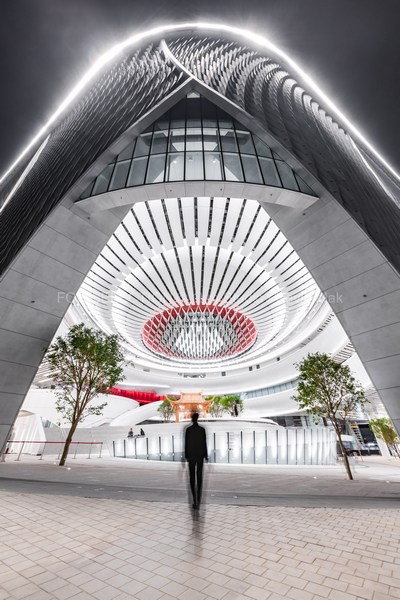 The first core facility in the West Kowloon Cultural District (WKCD) of Hong Kong to be commissioned, the Xiqu Centre, was officially opened in January 2019. Since then an unprecedentedly rich array of Chinese opera performances have since been staged to the awe and applause of many. Positioned as a prestigious performing arts venue, the Xiqu Centre is now host to the best Chinese Opera masterpieces, and is tasked with the mission to preserve, promote and advance Xiqu and other genres of the performing arts.
The first core facility in the West Kowloon Cultural District (WKCD) of Hong Kong to be commissioned, the Xiqu Centre, was officially opened in January 2019. Since then an unprecedentedly rich array of Chinese opera performances have since been staged to the awe and applause of many. Positioned as a prestigious performing arts venue, the Xiqu Centre is now host to the best Chinese Opera masterpieces, and is tasked with the mission to preserve, promote and advance Xiqu and other genres of the performing arts.
Located in Tsim Sha Tsui at the junction of Canton Road and Austin Road West, the Xiqu Centre is the first major performing arts venue to be completed in the West Kowloon Cultural District and was incorporated into the blueprint of the cultural precinct as early as 2006.
In 2009, Cantonese Opera was added to the World Intangible Cultural Heritage List, with the aim of reintroducing Chinese Opera to people of all ages and to rekindle interest in this art form to serve as a successor of this tradition. In 2012, the design project team made up of a collaboration between Bing Thom Architects (now known as Revery Architecture) and Ronald Lu and Partners (RLP) was chosen at a competition organised by the West Kowloon Cultural District Authority, with construction of the Xiqu Centre beginning in September 2013. From conception to birth, the journey lasted for more than 12 years.
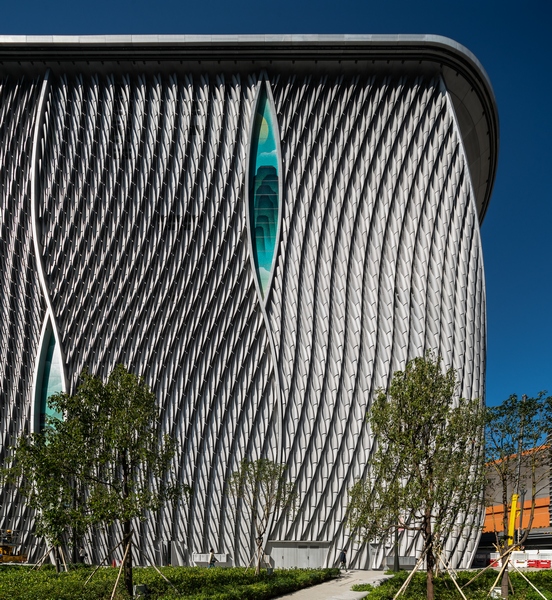 Bryant Lu, Vice Chairman of RLP recalls working hand in glove with Mr. Thom, at a time when many great ideas bounced off between the pair. “We spent a lot of time discussing whether the Grand Theatre should be on the ground level or elevated.” It was finally decided that the 1,073-seat Grand Theatre would be elevated to the 4th floor of the Centre, 30 metres above ground, thereby freeing up the space that would become the current Atrium offering a place to experience art and culture, and also simply sit back and relax.
Bryant Lu, Vice Chairman of RLP recalls working hand in glove with Mr. Thom, at a time when many great ideas bounced off between the pair. “We spent a lot of time discussing whether the Grand Theatre should be on the ground level or elevated.” It was finally decided that the 1,073-seat Grand Theatre would be elevated to the 4th floor of the Centre, 30 metres above ground, thereby freeing up the space that would become the current Atrium offering a place to experience art and culture, and also simply sit back and relax.
The importance of public space
The eight storey Xiqu Centre houses the Grand Theatre, the Tea House Theatre, the Atrium, a seminar hall, rehearsal studios, retail and food and beverage facilities. Mr. Lu stresses that in addition to a performing arts venue, the Xiqu Centre is also designed to serve as the eastern gateway to WKCD where a public space in form of a passageway is much warranted, justifying the cantilevered design of the Grand Theatre in order to accommodate the Atrium at ground level.
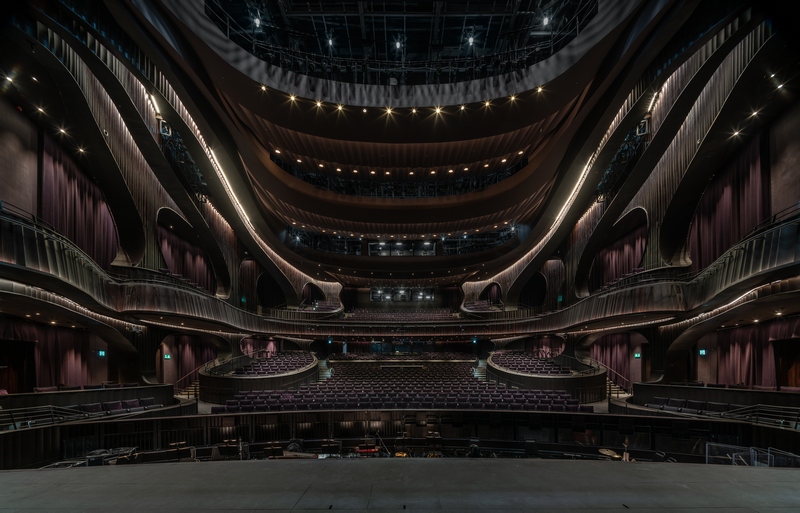 As Mr. Lu explains, if the Grand Theatre is situated at ground level, audiences will leave immediately after finishing the performance, discouraging them from venturing further into the Cultural District. In the future, he hopes when people visit the WKCD, they will meet at the Atrium of the Xiqu Centre. In such an event, it is hoped that the Centre will become a gathering point before the visitors decide the day’s itinerary at WKCD. While waiting, one can check out the various exhibitions on Chinese Opera or enjoy free small-scale opera performances, boosting the likelihood of the public to experience and appreciate the art of opera performances first hand in order to cultivate new audiences for the art form.
As Mr. Lu explains, if the Grand Theatre is situated at ground level, audiences will leave immediately after finishing the performance, discouraging them from venturing further into the Cultural District. In the future, he hopes when people visit the WKCD, they will meet at the Atrium of the Xiqu Centre. In such an event, it is hoped that the Centre will become a gathering point before the visitors decide the day’s itinerary at WKCD. While waiting, one can check out the various exhibitions on Chinese Opera or enjoy free small-scale opera performances, boosting the likelihood of the public to experience and appreciate the art of opera performances first hand in order to cultivate new audiences for the art form.
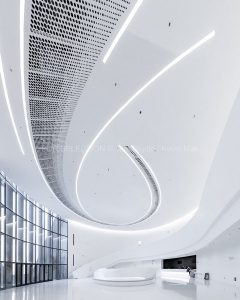 Of the 450 square metre Atrium, Mr. Lu contends the location is an ideal space for a small stage where the public can enjoy outdoor performances, thus making Chinese Opera more popular whilst at the same time facilitating cultural inheritance. He describes the Atrium as being well ventilated and comfortable but resilient against the onslaught of typhoons. “This kind of covered public space is well-suited to Hong Kong and I hope that our design of the Xiqu Centre will inspire other architects to do more in this regard.”The striking façade of Xiqu Centre is in a class of its own.
Of the 450 square metre Atrium, Mr. Lu contends the location is an ideal space for a small stage where the public can enjoy outdoor performances, thus making Chinese Opera more popular whilst at the same time facilitating cultural inheritance. He describes the Atrium as being well ventilated and comfortable but resilient against the onslaught of typhoons. “This kind of covered public space is well-suited to Hong Kong and I hope that our design of the Xiqu Centre will inspire other architects to do more in this regard.”The striking façade of Xiqu Centre is in a class of its own.
Inspired by traditional Chinese lanterns, the exterior is covered with more than 10,000 pieces of scaled fins that are designed to make the building shimmer under the evening lights. Its fluid and organic interior design is a modern interpretation of the traditional Chinese concept of “Qi” (flow), which as a world class performing venue make a radical departure from the conventional stereotype of Chinese Opera. Indeed, the design, coupled with an entrance shaped to resemble parted stage curtains, is an attempt to welcome audiences of all ages and backgrounds towards appreciating the art form and to entice visitors to venture inside the venue.
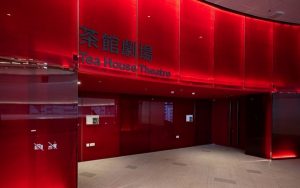 The Xiqu Centre was jointly designed by two architect firms. However, Mr. Thom unfortunately passed away in 2016 and did not live to see its completion.
The Xiqu Centre was jointly designed by two architect firms. However, Mr. Thom unfortunately passed away in 2016 and did not live to see its completion.
Speaking of this, Mr. Lu is emotional: “His passing was a shock to all of us. I was always thinking we both would be celebrate at the opening ceremony. Mr. Thom’s passing instilled a sense of responsibility in the team to give their very best to this project.” The white bench in the atrium, he said, was engraved with one of Mr. Thom’s statements: “I like to empower everyone, if you walk here and feel a little taller, I am happy.”
Space to shine
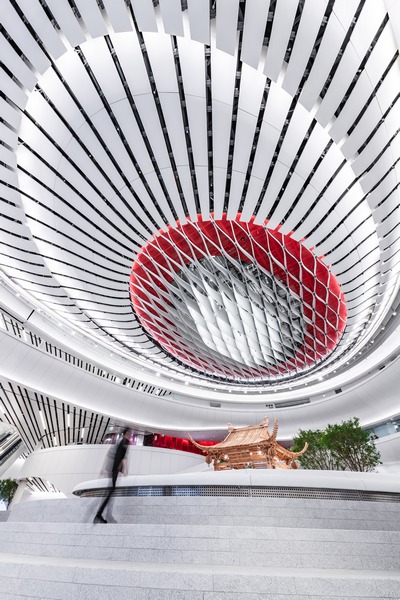 Bryant Lu anticipates the Xiqu Centre will be instrumental in motivating Hong Kong to devote more resources towards cultural arts. He contends the opening of the Centre will serve as “a shot in the arm” for the city’s cultural scene and expedite the nurturing of the next generation of talent. In addition to catering to audiences and the general public, the Xiqu Centre also provides a dedicated performance venue for Chinese Opera performers.
Bryant Lu anticipates the Xiqu Centre will be instrumental in motivating Hong Kong to devote more resources towards cultural arts. He contends the opening of the Centre will serve as “a shot in the arm” for the city’s cultural scene and expedite the nurturing of the next generation of talent. In addition to catering to audiences and the general public, the Xiqu Centre also provides a dedicated performance venue for Chinese Opera performers.
Previously no one has ever designed an orthodox Chinese Opera performance venue, thus there was no precedent and guidance to follow. Learning from its experience of designing the Ko Shan Theatre New Wing, RLP developed a deeper understanding of the requirements of the Chinese Opera performers. Many renowned Chinese Opera performers shared their needs during the design process, redefining the front and back stage, rehearsal studios and even the orchestral pit, enabling these facilities to better cater to the performers and helping them to deliver their utmost on stage.
“The stage enables a new generation of artists and producers access to more opportunities. Now this serves as a venue for them to hone their craft before embarking on the path to success.”
Mr. Lu hopes the versatility of the Atrium can attract the public to venture into the Xiqu Centre through staging exhibitions, bazaars, workshops and other activities related to traditional Chinese culture, where they will then buy tickets to the Teahouse Theatre and the Grand Theatre, grooming a younger audience in the process.
He believes that the cosmopolitan design of the Xiqu Centre will usher a new era for Cantonese Opera and other Chinese Opera performing arts, and entice the younger generation of audiences: “I want to attract young people to the Centre and to be excited about seeing performances there,” he adds.
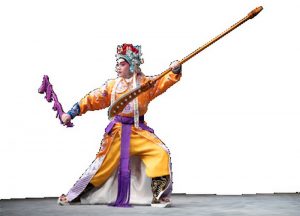 Finally, in addition to actors, Mr. Lu hopes that the Centre will become a venue for all types of performance arts talents, including lighting and costume design.
Finally, in addition to actors, Mr. Lu hopes that the Centre will become a venue for all types of performance arts talents, including lighting and costume design.
“It is our hope that young people will be inspired to develop future pathways, and see that one can still prosper by engaging in cultural arts and succeed on their own. Ultimately we believe the venue can play a significant role in transforming Hong Kong from a cultural desert into a cultural mecca.”
“Xiqu Centre’s fluid and organic interior design is a modern interpretation of the traditional Chinese concept of “Qi” (flow), which as a world class performing arts venue makes a radical departure from the conventional design of Chinese opera houses.”
Bryant Lu, Vice-Chairman, Ronald Lu & Partners











